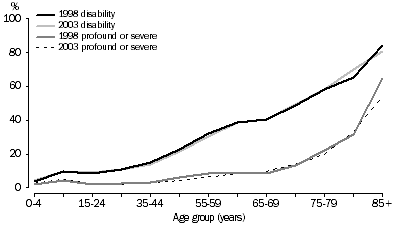DISABILITY
The following preliminary findings have been taken from the ABS publication Disability, Australia (cat. no. 4446.0), which was released on 11 May 2004. Final and more comprehensive results are expected to be published in September 2004 in Disability, Ageing and Carers: Summary of Findings, Australia, 2003 (cat. no 4430.0).
The statistics shown in this publication provide a summary of disability prevalence in Australia. As the results are preliminary they may be subject to change as further processing of the data is undertaken.
Disability rates
The 2003 SDAC estimates that one in five Australians (3,951,000 or 20%) had a disability. This rate was the same for males and females. The rate increased with age, reaching 81% for those aged 85 years and over. The age-standardised disability rates for total males, females and persons showed little change between 1998 and 2003 and the pattern across age groups was very similar in these two years.
The 2003 SDAC found that one in seventeen people (5.9%) had a profound or severe level of core activity limitation (i.e. they needed help with one or more self-care, mobility or communication activities), a slightly smaller proportion than in 1998 (6.4%). However, the rate for persons aged 85 years and over dropped more substantially, from 65% in 1998 to 54% in 2003, with the decrease more marked for males than females.
The pattern of prevalence of profound or severe level of core activity limitation differed across age groups from that of the overall disability population. There was a gradual increase in the rate for age groups 0-4 years (2.8%) through to 65-69 years (9.4%) but it then increased sharply to 54% of those aged 85 years and over. This contrasted with the overall disability rate which increased steadily from 4% of 0-4 year olds to 41% of 65-69 year olds and 81% of those aged 85 years and over.
ALL PERSONS, Disability status, 1998 and 2003

Education
People with a disability were less likely to have completed a higher educational qualification than those without a disability. In 2003, one in five people aged 15-64 years living in households who had no disability had completed a bachelor degree or higher, compared to one in eight people (13%) with a disability.
Employment
Employment-related findings, for people aged 15-64 years living in households, from the 2003 SDAC include:
- those with a profound level of core activity limitation had a much lower labour force participation rate (15%) than people without a disability (81%)
- people with a disability had a higher unemployment rate (8.6%) than those without a disability (5.0%)
- people with a disability who were employed were more likely to work in a part-time job (37%) than those who were employed and did not have a disability (29%).
For further information about these and related statistics, contact the National Information and Referral Service on 1300 135 070 or Ken Black on (02) 6252 7430.
 Print Page
Print Page
 Print All
Print All